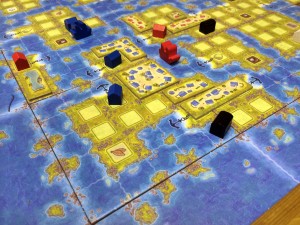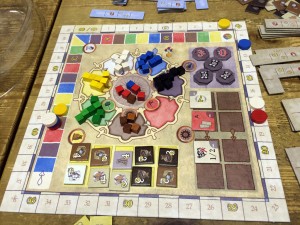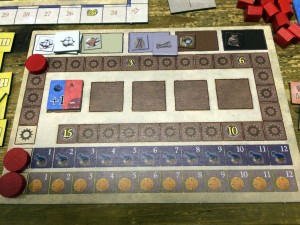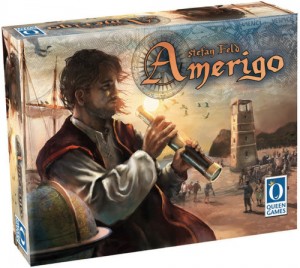Review: Amerigo
Posted by James (admin) on December 18th, 2013
 Amerigo is a game by Stefan Feld – a designer who has created some great game such as Bora Bora, Rialto, Trajan, Strasbourg, Die Speicherstadt to name just some that I’ve reviewed.
Amerigo is a game by Stefan Feld – a designer who has created some great game such as Bora Bora, Rialto, Trajan, Strasbourg, Die Speicherstadt to name just some that I’ve reviewed.
THE GAME
Like two other Queen Games (Shogun and Wallenstein), Amerigo uses a cube tower – a card tower with couple of card sections inside (like floors in a building) which have various holes in them. When cubes are dropped into the tower, some come out at the bottom and some are retained inside the tower on the card layers (which may fall out when more cubes are dropped into the tower later).
Made up of multiple tile sections, the board show grids of land and water spaces and, together, form islands. During the game, players explore and colonise islands by moving their ships, setting up trading posts and building villages. Players score Victory Points (VPs) for building villages, gathering goods (and increasing the value of their goods), developments, etc. The game lasts 5 rounds (each divided into 7 phases) and the player with most VPs at the end of the game wins.
So far, it sounds fairly standard but the core game mechanic – the action system – driving Amerigo is nicely different. There are 7 different actions that a player can take and each corresponds to a specific colour of cubes: Sail and place trading posts (Blue), Gain cannon (Black), Buy building tiles (Red), Development (Brown), Place building tiles (Green), Improve trade good values (Yellow), and Special (White).

Action board: This shows the action cubes as well as the turn order track, development tiles, pirate cannon tokens, and tiles that can be bought to raise your goods’ values.
The Action Board
Each phase all of the cubes of the current phase’s colour not already inside the tower are dropped into the cube tower. The cubes that come out of the tower each phase are placed in the middle of the action board and determine what actions the players can take. The most number of cubes of a single colour determines the number of action points (APs) a player can spend, and a player can spend this many APs on any action whose colour came out. For example (as shown in the photo), in the current phase the red cubes were dropped into the tower and 4 red, 1 blue and 1 brown cube came out – this means each player can spend up to 4 APs doing either the red, or the blue or the brown action (never a mixture).
Once a phase is complete, the action cubes that came out of the tower are placed in their respective colour areas on the action board, then all of the cubes of the next colour (going clockwise) are dropped into the tower to start the next phase. (In the photo, the brown cubes will be dropped in next.)
The action board also shows development tiles (special abilities) available that round which can be earned if a player s[ends enough brown APs to advance their development marker on their player board far enough.
The multi-coloured track on the action board is the the turn order track. The white action allows players to advance their turn order marker along the turn order track (which can earn VPs at game end), or they can use the action that matches the colour of the space where their turn order marker is located.
The 5 octagonal tokens on the action board are the pirate strength tokens – one is revealed at the start of each round (so the total increases during the game). Players can use black APs to increase their cannon total. At the end of each round (after 7 phases), the players must reduce their cannon total by the pirates’ total strength. If a player can not reduce by the full amount, they lose all their cannon and lose VPs equal to the pirates’ cannon total (regardless of how many cannons they lost).
The action board also shows tokens with different goods on which can be bought using yellow APs and these increase the value of goods a player may collect when they build on an island.

Player Board: Each player has their own player board where they track their cash, cannon, development, goods and goods value.
Moving and Building Villages
Spending blue APs lets a player move their ships and place a trading post if a ship ends its move on marked locations. Spending red and green APs allow players to buy, and place, village tiles respectively. Village tiles of a player’s own colour are cheaper and easier to buy; whereas, neutral colour tiles score more points but don’t cut off other players.
A player can only place village tiles if they can trace a path from the tile back to one of their trading posts via their own tiles and/or neutral tiles. So, without a trading post, a player can’t build on an island. A player receives 1 matching good tile if they place village tiles that cover land squares showing goods on. Goods are worth VPs at game end and spending yellow APs can increase their value.
Players score VPs for placing village tiles – more if they are on a large island. Also, when every space on an island has been covered, the player who finishes the island scores some bonus VPs (and gets a chest worth 3 gold if it’s a big island), plus all players that have trading posts score some VPs too (the earlier in the game, the more they get).
A player can skip their action to gain gold and gold can be used to add extra APs.
THOUGHTS
Amerigo has quite a lot going on inside it; however, it is pleasantly surprising that it is actually a fairly simple game to play as you have a limited amount of choice each turn. Also, you perform a single action each turn so they are short which means downtime is almost zero as players are almost constantly involved.
As you can not take an action unless at least one cube of the relevant colour drops out of the tower, Amerigo is a game of constant instant, short-term decision-making. You can have longer-term plans but you need to work out how to get there with the actions that become available to you and, sometimes, you need to know when to come up with a new long-term plan that better fits your situation.
In addition, the action system delivers an interesting push-your-luck element too as sometimes you are forced between picking an action you know you should take whilst it’s available, or picking an action you want to take at the risk the other action won’t show up again quickly enough. I like that you always know how many cubes of each colour are in the tower (because those that are not are on the action board) so you know what risks you are taking.

The building of villages is the core focus of the game and can be a brutal rush to grab land. Players often lay down a line of village tiles to secure an area of an island.
I found there was always an air of excited interest and tension over which cubes would drop out of the tower each turn. Plus, there’s further tension waiting to see where other players move and build, and which development and goods value tiles they take too.
There should be lots of variety in replay. The game board tiles are assembled randomly each turn so the islands will be different every game. Plus, the cube tower ensures the actions, and number of APs, each turn will be different throughout the game. Also, the order that the pirate strength tiles, development tiles, and goods value tiles appear in will vary each game too.
Amerigo is a game I really like but I do have a few minor issues to mention. Being first player in the first turn seems very powerful as it means you usually grab the island you want and then reserve a section of it unless turn order changes. The minimal extra cash you get during set-up for going later in the first turn doesn’t really feel like it’s enough to make up for this; however, maybe this is just because white actions haven’t appeared early in my games so there hasn’t been a chance for turn order to alter.
The VPs (and chest) earned for being the player that completes an island feel a bit arbitrary. In fact, this bonus encourages players to ringfence a small piece of island so they can control the completion of an island which makes it less likely islands get completed (not more).
I don’t mind that the game’s box is very large and I like games that provide a custom inner in the box which holds all the pieces well; however, the deep areas of Amerigo’s inner doesn’t leave any room to get your fingers in to reach the small items and it seems to turn an enormous box on the outside into a very small box on the inside.
The issues I have mentioned above are all minor, but there is one other issue that I hope it will be possible to fix. It’s not a problem with the game mechanics but with the tower itself which can affect the game mechanics. The gameplay relies on a mix of colours appearing each phase – not too many and not too few. However, whilst my tower retains a good amount of cubes at set-up, these reduce fairly quickly to the point that, in the last couple of rounds, almost all of the cubes dropped in the tower come straight out. This makes the game less interesting as all players end up doing almost the same action each phase. Also, it gives lots of APs and this means some actions are irrelevant near game end; for example, in my games, all players easily reached the end of their development track making the VPs unimportant.
I’ve read that other players find their cube tower is too generous too and there are some suggestions for fixing it by rotating the inserts, changing how you drop/pour the cubes in, etc. I’m sure I’ll find a way that makes the tower more retentive so I’m not too bothered by this at present as the game mechanics are very good. (I might simply add an even mix of cubes to the tower if too few are in it at the end of a phase.)
In conclusion, I really liked Amerigo. It has the usual Feld hallmarks of interesting game mechanics and constant, tricky decisions. I expect some experienced gamers will dismiss the cube tower as a gimmick, which would be a shame, because I think it delivers an excellent medium-weight eurogame of constant short-term decision-making. You can still have a strategy and you have more information on which to base your decisions than you would first expect. It worked well with 2 and 4 players.
James.
[Played with 2 and 4 players]


January 4th, 2014 at 11:30 pm
Amerigo is not a game that interests me, but I enjoy reading people’s opinions on it. I have learned I am not a Feld fan. I respect the man, but every time I get interested in his newest game (this happens a lot apparently) I end up wasting my money. I haven’t found a Feld game I like yet and there’s no way I’m buying this without playing it first. Anyway, my question is, do you ever review a game you don’t like? I would think most people would not want to devote the time needed to post a review of a game unless they enjoy it and want to promote it.
January 29th, 2014 at 11:48 am
Hi Jacob,
I always think it’s interesting how everyone has different likes and dislikes on any subject. For me, I usually like Feld’s games because of the different game mechanics he uses, but I understand he (or any designer) won’t be to everyone’s taste.
You asked if I review games that I don’t like. There is a larger proportion of mainly positive reviews on my site compared to mainly negative reviews. I’ve realised this for a while and I’m pleased to have the opportunity to explain it (in case people think I am biased, too positive, or not discerning enough).
It’s definitely not that I just think every game is great – far from it. I am highly critical and demanding of the games I play, and not only because game design is my professional job. I’ve played many games that are (in my opinion) terrible, boring and/or broken and have reviewed games that I didn’t like too. However, opportunities to play games are too few (and money too precious) to waste on unsatisfying experiences. As a result, I research the games I want to play and pick the ones that I think will be my kind of game. This means the proportion of the games I play that I enjoy is higher than if I picked them randomly off of a shelf.
To add to this, reviewing a game properly takes a long time which means I review fewer games than I play, and that means I get to pick which games I review from those that I’ve played. I much prefer to write, and tell people, about games that are good so they may enjoy them too; as opposed to writing about games that I don’t think are good which suggests to people which games not play but still leaves them not knowing what they should play.
So, the reason there are more positive reviews than negative is because I ensure that the proportion of games I play are likely to be good, and then I write about the best of those before any others.
Cheers,
James.